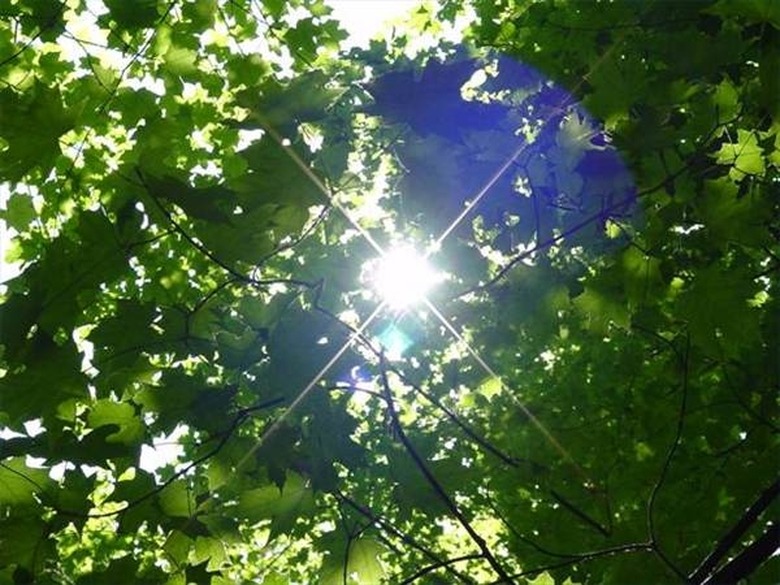What Happens When A Chlorophyll Molecule Absorbs Light?
When you think of the branch of science involved in how plants get their "food," you most likely consider biology first. But in reality, it is physics in the service of biology because it is light energy from the sun that first kicked into gear, and now continues to power, all life on planet Earth. Specifically, it is an energy transfer cascade set in motion when photons in light strike parts of a chlorophyll molecule.
The role of photons in photosynthesis is to be absorbed by chlorophyll in a way that causes electrons in a portion of the chlorophyll molecule to become temporarily "excited," or in a higher energy state. As they drift back toward their usual energy level, the energy they release powers the first part of photosynthesis. Thus without chlorophyll, photosynthesis could not occur.
Plant Cells vs. Animal Cells
Plant Cells vs. Animal Cells
Plants and animals are both eukaryotes. As such, their cells have far more than the bare minimum all cells must have (a cell membrane, ribosomes, cytoplasm and DNA). Their cells are rich in membrane-bound organelles, which perform specialized functions within the cell. One of these is exclusive to plants and is called the chloroplast. It is within these oblong organelles that photosynthesis occurs.
Inside the chloroplasts are structures called thylakoids, which have their own membrane. Inside the thylakoids is where the molecule known as chlorophyll sits, in a sense awaiting instructions in the form of a literal flash of light.
Read more about the similarities and differences between plant and animal cells.
The Role of Photosynthesis
The Role of Photosynthesis
All living things need a source of carbon for fuel. Animals can get theirs simply enough by eating, and waiting for their digestive and cellular enzymes to turn the matter to glucose molecules. But plants must take in carbon through their leaves, in the form of **carbon dioxide gas (CO2)** in the atmosphere.
The role of photosynthesis is to sort of catch plants up to the same point, metabolically speaking, that animals are at once they have generated glucose from their food. In animals this means making various carbon-containing molecules smaller before they even reach cells, but in plants it means making carbon-containing molecules larger and within cells.
The Reactions of Photosynthesis
The Reactions of Photosynthesis
In the first set of reactions, called the light reactions because they require direct light, enzymes called Photosystem I and Photosystem II in the thylakoid membrane are used to convert light energy for the synthesis of ATP and NADPH molecules, in an electron transport system.
Read more about the electron transport chain.
In the so-called dark reactions, which neither require nor are disturbed by light, the energy harvested in the ATP and NADPH (since nothing can "store" light directly) is used to build glucose from carbon dioxide and other carbon sources in the plant.
Chemistry of Chlorophyll
Chemistry of Chlorophyll
Plants have many pigments in addition to chlorophyll, such as the phycoerthryin and the carotenoids. Chlorophyll, however, has a porphyrin ring structure, similar to one in the hemoglobin molecule in humans. The porphyrin ring of chlorophyll contains the element magnesium, though, where iron appears in hemoglobin.
Chlorophyll absorbs light in the green portion of the visible section of the light spectrum, which in all spans a range of about 350 to 800 billionths of a meter.
Photoexcitation of Chlorophyll
Photoexcitation of Chlorophyll
In a sense, plant light receptors absorb photons and use them to kick electrons that have been dozing into a state of excited wakefulness, leading them to run up a flight of stairs. Eventually, neighboring electrons in nearby chlorophyll "homes" start running around, too. As they settle back into their naps, their scurrying back downstairs allows for sugar to be built through a complex mechanism that traps the energy from their footfalls.
When energy is transferred from one chlorophyll molecule to an adjacent one, this is called resonance energy transfer, or exciton transfer.
Cite This Article
MLA
Beck, Kevin. "What Happens When A Chlorophyll Molecule Absorbs Light?" sciencing.com, https://www.sciencing.com/happens-chlorophyll-molecule-absorbs-light-4922331/. 30 July 2019.
APA
Beck, Kevin. (2019, July 30). What Happens When A Chlorophyll Molecule Absorbs Light?. sciencing.com. Retrieved from https://www.sciencing.com/happens-chlorophyll-molecule-absorbs-light-4922331/
Chicago
Beck, Kevin. What Happens When A Chlorophyll Molecule Absorbs Light? last modified March 24, 2022. https://www.sciencing.com/happens-chlorophyll-molecule-absorbs-light-4922331/
